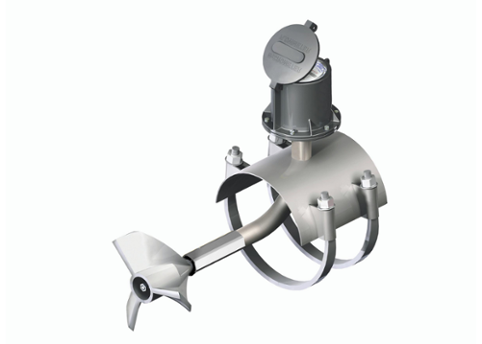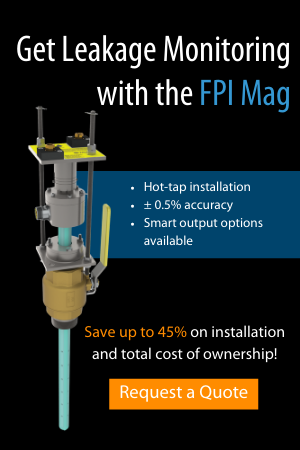McCrometer Insertion-Style Mag Meters: A Comparison
McCrometer offers four insertion-style electromagnetic (mag) meters, which have similar designs and product names. If you’re interested in an insertion mag meter, or are comparing them to traditional full-bore mag meters, here’s what you need to know in order to choose the right insertion mag for your flow project.
Popular Markets and Applications for Insertion-Style Mags
McCrometer’s saddle-style mag meters are more commonly installed into agriculture and irrigation applications, as their design is retrofit-friendly and offers an overall low cost of ownership. Many irrigation applications have a relatively low pipeline pressure, so McCrometer’s McMag2000™ and Mc®Mag3000 are a good fit, as they tolerate up to 150 PSI.
Both saddle-style meters are a favorite of farmers and irrigators as they’re portable, which is convenient for irrigating multiple fields in accordance with crop rotation. Additionally, the Mc®Mag 2000 is field-serviceable, preventing the need to send in the flow meter for any maintenance or repair should it be necessary.
For municipal and industrial verticals, the full-profile insertion meter, FPI Mag®, is an increasingly popular choice for customers seeking a unique meter offering a quick and easy installation process. The hot-tap capabilities of both the FPI Mag and the similar-sounding SPI Mag™, McCrometer’s single-point insertion mag meter, are extremely beneficial to municipalities wanting to avoid shutting down a pipeline for a time-consuming, costly installation.

A recently installed FPI Mag in a municipal application.
Although the FPI Mag and the SPI Mag are compatible with municipal and industrial verticals, the FPI is often chosen more in municipal applications due to the unique full-profile and highly accurate reading the FPI Mag provides, up to ± 0.5%. Precision and accuracy are often highly coveted in municipal water applications, and the FPI Mag’s sensing electrodes allow the meter to read bidirectional flow.
At up to ± 2% accuracy, the SPI Mag is often preferred for industrial measurement as customers want operational efficiency but are required to report flow measurement in the same manner as the municipal industry. As the SPI Mag only takes a single point reading of the flow, the measurement device is a more “off the shelf” solution, as the cost isn’t dependent on line size as the FPI Mag is. This, along with the SPI’s ability to read over a wide variety of flow ranges, make it a desirable choice for customers wanting a price-conscious yet operationally effective insertion mag.
Insertion Mags and Various Media
Due to these meters operating on the principles of electromagnetic induction, each of the four insertion mags must operate with a conductive media in order to function properly. If an application has a lot of turbidity in the flow, or if there is debris in the line, it can hit the sensor and cause problems for the electrodes to measure the flow properly. Angled sensors like that of the Mc®Mag 2000 and the Mc®Mag 3000 are more debris-shedding by design. If the media is flowing at a high enough velocity it can better prevent the media from sticking to the electrodes, so fast-flowing slurry applications will have a more successful venture in using a more invasive meter like the FPI Mag.
A good rule of thumb for municipal applications is to implement an FPI Mag for upstream water treatment and distribution, and an SPI for downstream wastewater. The sensors on an SPI are flush with the probe, rather than raised, which will assist with shredding debris on an already minimally-invasive meter.
For industrial applications flowing media such as slurry, pulp, and paper the SPI Mag is a great choice for easy installation and maintenance. The meter can be removed for cleaning without needing to shut down the line and interrupt processes. The SPI Mag’s ProComm converter will alert the customer when readings and flow rates start dropping, indicating that the meter needs cleaning. The hot-tap capabilities of the SPI Mag make it an efficient choice for engineers and professionals who want to maximize operational efficiency and minimize downtime.
Insertion Mags: Problem Solving, One Application at a Time
Whereas the SPI Mag is more of an “off the shelf” solution, the FPI Mag is highly customizable – which can often be the solution to some customers’ toughest flow measurement challenges.
For instance, a municipal customer was at a project-standstill when attempting to find a solution for their 24” pipeline flow measurement. Normally, a project like this has a myriad of options available, but the installation site was buried eight feet underground. To accommodate other meter solutions, the customer would have had to dig up the area and put in a vault, a time-consuming and costly venture. McCrometer’s flexibility of manufacturing the FPI Mag allowed the creative solution to install a 109” FPI Mag sensor through a stack pipe to measure the 24” pipe needing flow monitoring. The customer was able to avoid the vault and costly installation process while receiving the benefit of the FPI Mag’s hot-tap capabilities and accurate readings.
Mag Misconceptions and Choosing the Right Mag for You
For customers trying to choose between the Mc®Mag 2000 and the Mc®Mag 3000 in both agriculture and municipal applications, we recommend checking out our blog covering the topic, which goes into more detail comparing the specifications and the various benefits of each meter.
For customers considering the FPI Mag and the SPI Mag, the significant differences start to emerge when comparing the two meters for a large line size application. The larger the line size, the higher the cost of the FPI compared to the SPI Mag, whose cost is independent of line size. The FPI Mag is a very powerful measurement tool with incredible accuracy but it can often carry the misconception that it is a larger version of the SPI Mag. These two meters have different performance and price points and will bring diverse benefits to each application they’re considered for.
The best way to determine which mag will meet the needs of your unique flow application is to talk to the experts at the McCrometer factory. Each application needs a custom approach that takes your flow project details into account in order to prescribe a meter that helps fulfill your project goals and gets you the flow data you need for daily operations management.
Check out our insertion mag product suite and reach out to the factory for additional information.
Related Posts
Featured Posts
Get into the Groove: McCrometer’s Grooved-End Mag Meter
We’ll share the big news upfront! McCrometer’s integrated grooved-end mag meter is the only version on the market, and it’s revolutionary for a reason. Engineered to meet customer demand, this meter launched in January 2024 and is available for order now. This...
Produced Water and Blending Flow Meter Use Case
Produced Water is a byproduct of oil production. Whether it is a byproduct of flow back or the water component of the oil separation process, produced water can be a difficult measurement point but is a very important part of the process. Several parameters make it...
Get your Groove on Now: McCrometer’s Grooved-End Mag Meter Now Available
It is time to get your Groove On. McCrometer has released their innovative Electromagnetic Flow Meter with integrated Grooved End connections. Are you tired of bolting on extra flanges with Victaulic end connections welded to them? It is time consuming and makes an...
Request More Information








